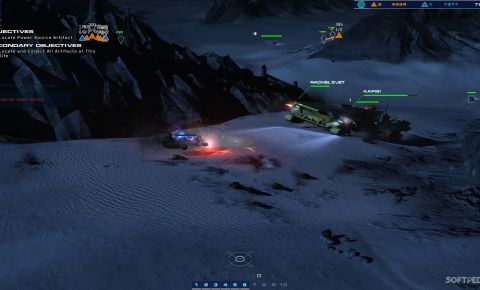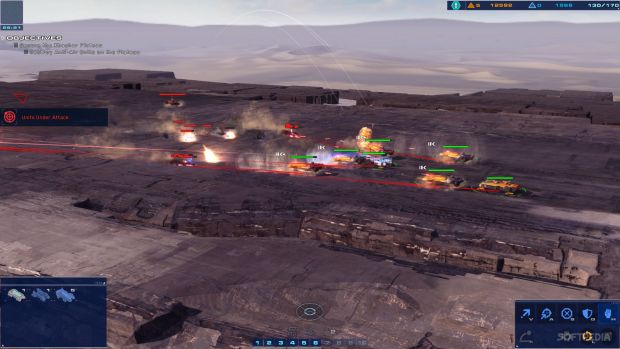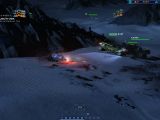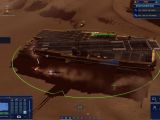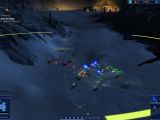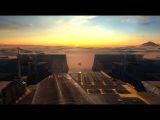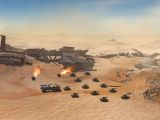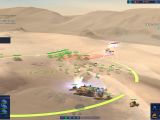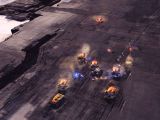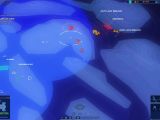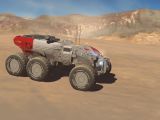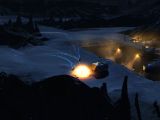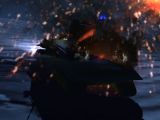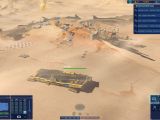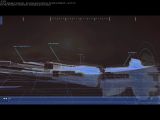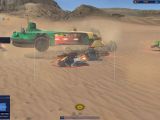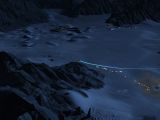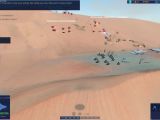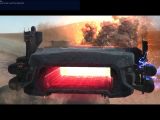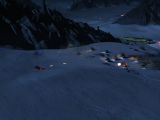Strike fighters are roaring overhead as my assault vehicles are moving towards the top of a dune, knowing full well that a powerful enemy group is situated in the valley beyond it, protecting a resource harvester that's trying to resupply a powerful enemy carrier group.
As the two groups exchange fire, I switch to my tactical map to see the two air defense groups that my Gaalsien opponents are moving out of position, and quietly thank my baserunners for the solid scanning network they have established.
The land battle is important, but it's mostly designed as a feint, drawing enemy forces away from their defensive lines as two tactical bombers and the rest of my aircraft head to the enemy command vessel and deliver an almost fatal blow, with my ground troops then moving in to finish the job.
Homeworld: Deserts of Kharak is not the sequel that fans of the space strategy title launched in 1999 were expecting, but the game offers its own brand of interesting mechanics and some cool story moments, a solid foundation for the future of the franchise.
Homeworld: Deserts of Kharak is developed by Blackbird Interactive, with publishing duties handled by Gearbox Software, offered only on the PC.
Story
Homeworld: Deserts of Kharak features a narrative that is clearly meant to reflect that of the original installment in the series, with a massive carrier, the sand dune based version of the mothership, launching on a perilous mission in unknown space just as the race that built it comes under attack from historic rivals.
Rachel S'Jet is the closest that the title has to a main character, ancestor to one of the most interesting figures in the original title and a scientist on a quest to find out what that signal buried under the desert represents, and how it can influence the future of her people.
The role of the mothership is played by the Kapisi, a carrier that moves across the impressive dunes of Kharak with a complement of other smaller vehicles and aircraft, fighting off enemies while investigating anomalies.
The story created by Blackbird Interactive has plenty of interesting moments, although the characters tend to remain a little flat, and it's strong enough to keep the player engaged as they move through the missions.
I especially appreciate the small audio diaries in Homeworld: Deserts of Kharak, narrated from a variety of perspectives, which play after a mission is over, clearly designed to connect the player with the crew of the Kapisi and show how the pressure of both their future and their past shapes their actions.
Both the video and the images in this review contain minor spoilers for the campaign.
Gameplay
Homeworld: Deserts of Kharak is a real-time strategy title that closely resembles the core concepts of the two previous installments in the series, abandoning the emptiness of space for the dunes of the desert.
There's no mothership, but the Kapisi acts like a similar base of operations, able to manufacture a variety of hardware while also using its core systems to battle enemies, repair allies or simply boost their abilities.
As the campaign progresses, a range of hardware is introduced, from fast and mobile attack vehicles to powerful tactical bombers and capable support cruisers, all with unique special powers and upgrades that improve attack and survivability.
By moving from space to the surface of Kharak, the game loses a little tactical depth, and there are no options to use formations or attack stances to add complexity to tactical plans.
The new Homeworld wants players to mix and match units to emphasize their strengths, and terrain plays a major role, with dunes offering a height advantage to land units while also creating natural chokepoints to exploit and ways to cover advances on enemy positions.
A combined arms approach that features a strong vehicle force backed by solid air strike capabilities is the best way to deal with enemy forces, and the Artificial Intelligence does a good job of counterattacking weak groups, causing casualties and slow assaults.
The Kapisi itself grows in power as the campaign progresses, and more alien tech is integrated. Thus, players will need to decide whether they want to use the carrier as a powerful if slow offensive unit or only as a base to heal friendly units and make sure that their veteran levels, which offer some solid bonuses, are preserved.
“Homeworld: Deserts of Kharak offers plenty of variety when it comes to the missions, ranging from artifact digging while under fire to base attacks and escort sequences, with the environment sometimes becoming an important part of the battle.”
The freedom of movement in 3D space that the series pioneered cannot be matched, but there are plenty of strategic choices to make in the new game, and some of the battles are very difficult even for an experienced real-time strategy fan.
Homeworld: Deserts of Kharak also features a classic skirmish mode that allows gamers to battle the Artificial Intelligence on five maps that accommodate a few modes and a wide variety of tactical approaches.
Graphics and audio
Homeworld: Deserts of Kharak delivers some impressive sights, ranging from the red sunrises that dominate the cutscenes to the explosion-filled battles that rage across the empty and majestic dunes.
The aesthetics of the new game stays very close to that of the first two installments, with the blue glow of the launch bays and the design of the various units serving as a powerful dose of both nostalgia and foreshadowing.
I spent most of my time on the overhead tactical view, which is packed with information about the battlefield, directing unit movement and planning long-term strategies, but Homeworld: Deserts of Kharak is smart enough to give players plenty of quiet moments when they can zoom in to see the battles and destruction.
There are moments when both the cutscenes, with their subtle cell shading, and the real-time action show the limits of the engine powering the game, but Blackbird Interactive does a good job of using spectacle to mask them.
Homeworld: Deserts of Kharak also sounds good, with plenty of atmospheric tracks that underline the monumental undertaking the player task force is facing. At the same time, the game features voice acting that manages to mix melancholy, awe, and determination in equal measure, especially when Rachel S'Jet is involved.
Multiplayer
Homeworld: Deserts of Kharak offers a full-fledged multiplayer mode, with both ranked and unranked matches, which allows gamers to test their skills against other human opponents using the same units seen in the single player.
The asymmetry between the two featured sides means that there are some interesting strategies to learn for both the Coalition and the Gaalsien, and there's plenty of tension featured when the two sides are aiming to secure artifacts rather than simply destroy each other.
The Good
- Homeworld-themed story
- Solid RTS mechanics
The Bad
- 2D is not as interesting as 3D in terms of strategy
- Stays too close to the Homeworld formula
Conclusion
The sand-dominated environments offer a perfect place for big and spectacular battles, and the game does not disappoint when it comes to the delivery of complex missions that involve careful planning and execution.
The zoomed-out tactical view is very useful, especially when two- or three-pronged attacks are required to take out an enemy fortified position, but I urge gamers to zoom into the action from time to time and to press Ctrl-H to strip out the user interface and just look at the combat and its explosive results.
Blackbird Interactive does not break any new narrative ground, but the character-driven audio diaries are interesting and offer a great look at the struggles that take place on Kharak and foreshadow the conflict that will take place among the stars in the other two titles.
Homeworld: Deserts of Kharak pre-orders come with a copy of the collection that includes remastered versions of the first two titles in the franchise, which makes it a great deal for those who have never experienced it before.
For long-term fans, the title delivers a solid set of strategy mechanics and shows how the ideas first introduced in 1999 can be adapted for modern audiences in an entertaining way.
 14 DAY TRIAL //
14 DAY TRIAL // 